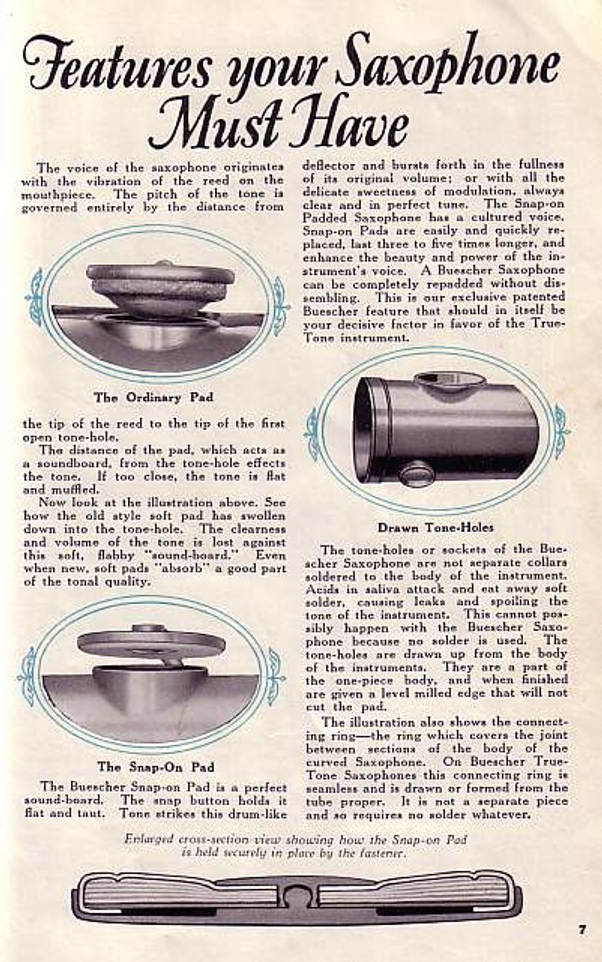Feature Page: Snap-On Pads
Yes, "Snap-On", not "Snap-In". Hey, the former is in the Buescher documentation I've seen. Sorry to disappoint.

The voice of the saxophone originates with the vibration of the reed on the mouthpiece. The pitch of the tone is governed entirely by the distance from the tip of the reed to the tip of the first open tone-hole.
The distance of the pad, which acts as a soundboard, from the tone-hole effects the tone. If too close, the tone is flat and muffled.
Now look at the illustration above. See how the old style soft pad has swollen down into the tone-hole. The clearness and volume of the tone is lost against this soft, flabby "sound-board." Even when new, soft pads "absorb" a good part of the tonal quality.
The Buescher Snap-on Pad is a perfect sound-board. The snap button holds it flat and taut. Tone strikes this drum-like deflector and bursts forth in the fullness of its original volume; or with all the delicate sweetness of modulation, always clear and in perfect tune. The Snap-on Padded Saxophone has a culture voice. Snap-on Pads are easily and quickly replaced, last three to five times longer, and enhance the beauty and power of the instrument's voice. A Buescher Saxophone can be completely repadded without dissembling. This is our exclusive patented Buescher feature that should in itself be your decisive factor in favor of the True-Tone instrument.
The tone-holes or sockets of the Buescher Saxophone are not seperate collars soldered to the body of the instrument. Acids in sailva attack and eat away soft solder, causing leaks and spoiling the tone of the instrument. This cannot possibly happen with the Buescher Saxophone because no solder is used. The ton-holes are drawn up from the body of the instruments. They are a part of the one-piece body, and when finished are given a level milled edge that will not cut the pad. The illustration also shows the connecting ring - the ring which covers the joint between sections of the body of the curved Saxophone. On Buescher True-Tone Saxophones this connecting ring is seamless and is drawn or formed from the tube proper. It is not a seperate piece and so requires no solder whatever.1
There were two Snap-On patents:
| Number/Link | Applicant | Date Applied | Date Granted |
| US1401872 | FA Buescher | 02/28/1921 | 12/27/1921 |
| US1702962 | FA Buescher | 12/09/1924 | 02/19/1929 |
The 1921 patent is the one that's actually stamped on the Snap-Ons, themselves. Also note that the Snap-Ons had the same finish that the horn did.
The good folks at Cybersax also have an article on the Snap-On pads here.
Places like musicmedic.com (which conveniently lists your Buescher pad sizes in millimeters) still sell Buescher Snap-Ons and several higher-end repairmen can "remanufacture" the Snaps (see the Cybersax article, above).
A post-1921 horn without Snaps is not worth as much as a horn with Snaps and most folks that buy Bueschers look for them.















